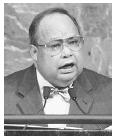NAURU
René Harris
President

(pronounced "reh-NAY HAIR-ess")
"Our priorities are, in essence, to cut our losses and to maximize our human resources potential."
The Republic of Nauru (pronounced "NAH-roo") is distinctive in many ways. With an area of less than 22 sq km (little more than 8 sq mi), Nauru is the world's smallest independent nation. The single, tiny island lies 41 km (25 mi) south of the equator at a latitude of 0º south and a longitude of 167º east. On the inland side of the island, a coral cliff rises up to 300 m (less than 1000 ft) above sea level; this central plateau was the site of phosphate deposits. Due to its isolated location, birds nested on Nauru for thousands of years, leaving behind vast deposits of phosphate-rich guano. The island was once covered in dense tropical forest, but mining for phosphate during the past 90 years stripped this vegetation, leaving most of Nauru a strange, jagged landscape. A narrow fertile belt rimmed by sandy beaches still encircles the island. Temperatures range from 23º to 32ºC (73º to 90ºF) year round. Rainfall is heavy from November through February and sporadic during the other months.
The population of Nauru was estimated at 12,329 in 2002, about 58% made up of ethnic Nauruans. The remainder consists of migrant workers from Tuvalu and Kiribati, ethnic Chinese, and Europeans, almost all employed in some capacity in the phosphate industry. After years of population decline, ethnic Nauruans are now increasing rapidly in numbers. About 40% of the current population is estimated to be under the age of 15. The official language is Nauruan, classed within the Micronesian family of Austronesian languages. Most Nauruans also speak English, the language of commerce, government, and education. Representatives of the London Missionary Society brought Christianity to Nauru more than 100 years ago. About 60% of Nauruans are members of the Nauruan Congregational Church; most of the remainder are Roman Catholics. Nauruans enjoy a high standard of living in terms of a Western lifestyle. This has resulted, however, in both the loss of cultural traditions and increasing health problems. Changes in diet, including use of alcohol, have resulted in declining health and obesity; about 50% of the population has diabetes, an alarming statistic that some experts believe may be the highest rate of diabetes in the world.
Throughout the 20th century, the economy of Nauru was synonymous with phosphate mining. Phosphate is a key ingredient in agricultural fertilizers. Until the early 1990s export of phosphate provided Nauruans with one of the region's highest per capita incomes, at approximately US $10,000; however, by 2000, the decline in both the world demand for phosphate and Nauru's reserves caused this per capita income to decline (it stood at approximately US $5,000 in 2001). All modern infrastructure (the airport, national airline, railroad, paved roads, telephone system, and the single luxury hotel) was developed to support the phosphate industry. Apart from coconuts, there is no agricultural activity on the island. Almost everything is imported, including fresh water.
After phosphate production peaked in the 1980s, phosphate reserves began to decline significantly in the 1990s. Every government since independence has invested a significant portion of phosphate revenues, much of it in overseas real estate, in an effort to cushion the effects of the loss of this income. The loss of millions of dollars, however, to swindlers in various schemes including unsuccessful investments in the Philippines and India have caused a financial decline in recent years. After years of deficit spending to make up for lost revenues, the deficit reached 18% of gross domestic product (GDP), and has created substantial debt which, in early 1996, made Nauru incapable of meeting the salaries for its civil servants and placed the country in default on its external debt service.
Some consideration was given in the late 1990s to creating a tourist industry, but this would be dependent on developing public and private infrastructures. The minimal facilities that exist on the island had been allowed to fall into disrepair, and the Asian economic crisis of the late 1990s diminished considerably the prospects for tourism from that part of the world, so development had not gone forward as of 2003. Fishing has some economic potential. The national currency is the Australian dollar.
ADDRESS
Office of the President
Government Offices
Yaren District, Nauru
Comment about this article, ask questions, or add new information about this topic: